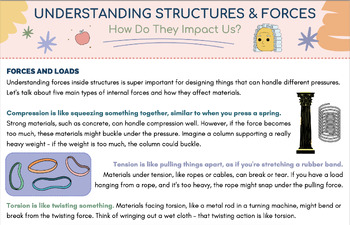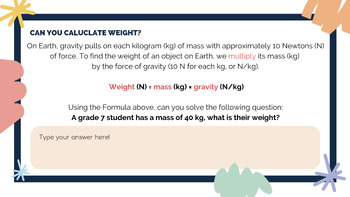Intro Structures and Forces Research Activity Bundle - Alberta 7 Science
Sara Syed
6 Followers
Grade Levels
1st - 12th, Homeschool
Subjects
Resource Type
Formats Included
- Zip
Pages
13 pages
Sara Syed
6 Followers
Products in this Bundle (2)
Description
Students will:
1. Describe and interpret different types of structures encountered in everyday objects, buildings, plants and animals; and identify materials from which they are made
- recognize and classify structural forms and materials used in construction (e.g., identify examples of frame structures, such as goal posts and girder bridges, examples of shell structures, such as canoes and car roofs, and examples of frame-and-shell structures, such as houses and apartment buildings)
- interpret examples of variation in the design of structures that share a common function, and evaluate the effectiveness of the designs (e.g., compare and evaluate different forms of roofed structures, or different designs for communication towers)
- describe and compare example structures developed by different cultures and at different times; and interpret differences in functions, materials and aesthetics (e.g., describe traditional designs of indigenous people and peoples of other cultures; compare classical and current designs; investigate the role of symmetry in design)
- describe and interpret natural structures, including the structure of living things and structures created by animals (e.g., skeletons, exoskeletons, trees, birds’ nests)
- identify points of failure and modes of failure in natural and built structures (e.g., potential failure of a tree under snow load, potential failure of an overloaded bridge)
2. Investigate and analyze forces within structures, and forces applied to them • recognize and use units of force and mass, and identify and measure forces and loads
- identify examples of frictional forces and their use in structures (e.g., friction of a nail driven into wood, friction of pilings or footings in soil, friction of stone laid on stone) 24/ Grade 7 Science Unit D: Structures and Forces ©Alberta Education, Alberta, Canada
- identify tension, compression, shearing and bending forces within a structure; and describe how these forces can cause the structure to fail (e.g., identify tensile forces that cause lengthening and possible snapping of a member; identify bending forces that could lead to breakage)
- analyze a design, and identify properties of materials that are important to individual parts of the structure (e.g., recognize that cables can be used as a component of structures where only tensile forces are involved; recognize that beams are subject to tension on one side and compression on the other; recognize that flexibility is important in some structures)
- infer how the stability of a model structure will be affected by changes in the distribution of mass within the structure and by changes in the design of its foundation (e.g., infer how the stability of a structure will be affected by increasing the width of its foundation)
Total Pages
13 pages
Answer Key
Does not apply
Teaching Duration
2 hours
Report this resource to TPT
Reported resources will be reviewed by our team. Report this resource to let us know if this resource violates TPT’s content guidelines.



